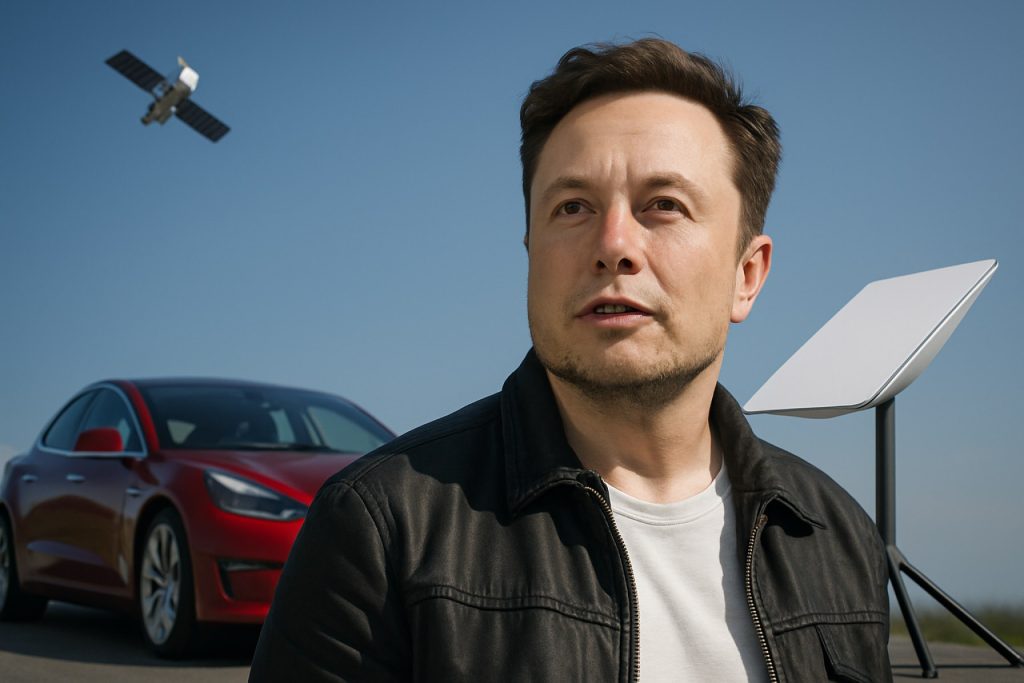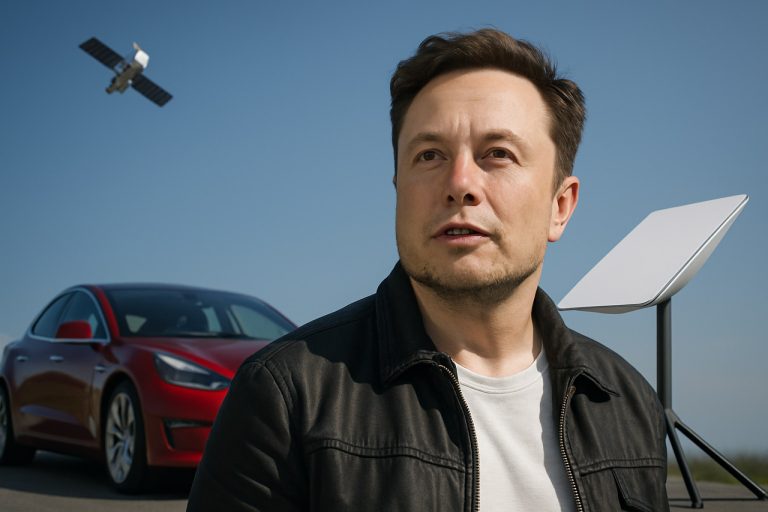
- Elon Musk confirms he will remain CEO of Tesla for at least five more years, quashing departure rumors and emphasizing his long-term vision.
- Tesla saw a 9% drop in U.S. deliveries and a 15% fall in share price earlier this year but has rebounded above a $1 trillion market cap with strong international sales.
- Starlink continues rapid global expansion, now operating in over 70 countries and poised for major growth in India and Africa, aiming to bridge digital divides.
- Regulatory shifts in South Africa could enable Starlink to connect millions currently without reliable internet access.
- Musk plans to reduce political spending after controversy, focusing on technological innovation—including autonomous vehicles and robotics—while maintaining voting control at Tesla.
Through summer haze and high-stakes boardroom whispers, Elon Musk is doubling down. The world’s most unpredictable billionaire insists he will remain at Tesla’s helm—unchallenged, at least for the next five years. The message is unmistakable: rumors of Musk’s exit are no more than rumors, with Tesla’s chair denying any search for his replacement and the man himself, speaking from a video link in Doha, looking beyond controversy.
The air crackles with a mix of promise and skepticism as Tesla rides a roller-coaster of public opinion. Stubborn protests trail Musk in Europe, fueled by his political entanglements and a style that sets Twitter alight. U.S. deliveries dropped 9% earlier this year—an arresting figure for a company of Tesla’s stature. Its share price has sagged nearly 15% this year, a sobering reality in a sector driven by aspiration and relentless innovation.
Yet, as of today, market confidence appears to have rebounded. Tesla’s market cap, ever the bellwether, thrusts above $1 trillion once again, fueled by strong sales outside Europe and rumors of surging demand in China and South America. Musk, with characteristic bravado, frames this rebound as inevitability—the market, he notes, “is aware of the situation.” Tangible evidence or bravado? For now, numbers offer the best argument.
Simultaneously, Starlink—the low-earth-orbit sibling in Musk’s constellation of companies—carves its own high-speed trail. The satellite internet provider now glints across more than 70 countries, slashing digital divides in places where fiber optics never dared to reach. Expansion plans toward India and the doors opening in Africa signal Starlink’s broader ambition: not merely to connect, but to redefine the concept of connection itself.
South Africa now stands at the brink of a seismic regulatory shift. National authorities, seeking a workaround for restrictive Black ownership laws, are poised to clear a path for Starlink, opening doors that could connect millions who’ve grown up beyond the internet’s reach. For Musk, it’s less about paperwork and more about breaking boundaries.
Meanwhile, the man at the center hammers home his own reasoning for clinging to Tesla. Musk, wary of “activist investors” and citing recent legal standoffs over his pay structure, insists on “sufficient voting control.” To him, it’s about the future—one that evokes images of fleets of humanoid robots, swarms of autonomous vehicles, and a company immune to the pressures of hostile boardroom politics.
After a year marred by political controversy—including headlines over a $270 million donation to Donald Trump’s presidential campaign—Musk promises to dramatically reduce political spending, refocusing his energies where disruption is most profound: technology, not politics.
The takeaway? When Musk pledges to stay the course, the stakes rise for the entire industry. Whatever you think of his methods, his vision for a connected, electrified, and increasingly automated future is shaping up in real time. And, if his record is anything to go by, the next five years may prove to be the most transformative yet—for Tesla, Starlink, and the way the world moves and communicates.
Watch this space.
Elon Musk Doubles Down: What’s Next for Tesla, Starlink, and the Future of Connected Tech?
Elon Musk’s Leadership: Beyond the Headlines
Elon Musk’s declaration to remain at Tesla’s helm for the next five years—paired with a public denial of CEO succession plans—comes at a pivotal juncture for the electric vehicle (EV) and space-tech sectors. While the source article captured the drama and intrigue surrounding Musk, several crucial facts, real-world trends, and actionable insights go deeper.
—
Key Facts & Developments Not Fully Explored
– Tesla’s Global Production Shift: Tesla’s Gigafactories in Texas, Shanghai, and Berlin are setting new standards in automated manufacturing and battery development. The Berlin factory recently increased Model Y production output to over 5,000 units per week, addressing European demand shortfalls (Reuters).
– Chinese Market Dynamics: Despite slowing sales in the U.S. and Europe, Tesla saw a 20% year-over-year increase in Chinese deliveries, with sales driven by localized Model 3 and Model Y production. Partnerships with Chinese battery suppliers like CATL give Tesla cost advantages few U.S. automakers can match (Bloomberg).
– AI and Robotics Ambitions: Tesla’s “Optimus” humanoid robot project is moving from the prototype to field-testing stages. Musk has highlighted plans for these robots in both manufacturing and consumer settings—potentially revolutionizing logistics and elderly care (TechCrunch).
– Starlink’s Regulatory Battles and Expansions: In addition to South Africa, Starlink is actively negotiating licenses in India, Indonesia, and Nigeria, where connectivity gaps slow economic growth. Recent deals with airliners and cruise ships expand Starlink’s reach into the lucrative travel sector.
– Tesla Semi and Cybertruck Launches: The Tesla Semi is in limited production, with PepsiCo among the first major customers, demonstrating real-world freight routes. The Cybertruck’s long-awaited mass delivery is anticipated within the year, per Musk’s recent shareholder address.
—
Real-World Use Cases
– Starlink in Education: Rural schools in the Amazon rainforest and Arctic Alaska have adopted Starlink to provide stable online classes and resources to previously disconnected communities (CNBC).
– Tesla Energy Solutions: Tesla’s Powerwall and Megapack batteries are stabilizing electrical grids in California and South Australia, reducing blackouts and integrating solar energy at scale.
—
Market Forecasts & Industry Trends
– EV Market Growth: According to the International Energy Agency, global EV sales are projected to grow 35% year-on-year in 2024, with Tesla remaining the dominant single-brand player despite rising competition from BYD, Hyundai, and Volkswagen.
– Satellite Internet Expansion: Analysts forecast global satellite broadband revenue to surpass $20 billion by 2027. Starlink’s share is expected to dominate, with over two million subscribers already (Morgan Stanley).
—
Reviews, Comparisons & Key Features
– Starlink vs. Competition: Starlink outperforms traditional satellite services (Viasat, HughesNet) in latency and speed (median download: 80-150 Mbps vs. 15-25 Mbps), but faces competition from Amazon’s Project Kuiper as it ramps up launches.
– Tesla: Pros & Cons Overview
Pros: Best-in-class autonomous vehicle software, supercharging network, brand cachet, vertical integration of manufacturing.
Cons: Service delays, quality control lapses, high sticker prices.
– Pricing Snapshot:
– Tesla Model 3 base price: $38,990 (U.S.)
– Powerwall battery: ~$8,700
– Starlink hardware: $599; monthly service: $110
—
Security, Sustainability & Controversies
– Security: Tesla’s vehicles and Starlink systems rely on frequent over-the-air software updates. However, security experts warn that increased connectivity could open new attack vectors, making cybersecurity investments crucial (Wired).
– Sustainability: Tesla is pushing the auto industry toward 4680 battery cells, which use less cobalt and are easier to recycle. Starlink satellites are designed to deorbit within 1-5 years, limiting space debris.
– Controversies:
– Worker rights and unionization at Tesla factories remain sensitive; recent labour board rulings demanded reinstatement of fired union organizers.
– Musk’s personal tweets and political donations have led to stock price volatility and shareholder lawsuits.
—
Frequently Asked Questions
– Will Musk’s focus on AI and robotics distract from Tesla’s EV business?
Most analysts argue that Tesla’s investment in AI, FSD (Full Self-Driving), and robotics enhance automotive competitiveness rather than detract from it.
– How reliable is Starlink in challenging weather?
Customer reviews show Starlink remains operational through most storms, but performance may degrade in heavy snow or dense forested areas.
– Is Tesla still the ‘best buy’ for new EV owners?
While legacy carmakers are closing the gap, Tesla maintains a lead in overall driving range, charging infrastructure, and software features.
—
Actionable Recommendations & Quick Tips
1. For Prospective Tesla Buyers:
– Monitor for seasonal discounts; Tesla often adjusts pricing quarterly.
– Consider the Model Y for the best blend of range and price.
– Use referral codes for free Supercharging miles.
2. For Interested Starlink Users:
– Check Starlink’s official map for service availability and expected installation times in your region.
– Secure hardware early—waitlists can extend for months in some markets.
3. For Investors:
– Diversify within the clean-tech sector; consider exposure to battery suppliers, EV infrastructure, and satellite tech alongside Tesla holdings.
4. For Tech Enthusiasts:
– Follow Tesla’s annual AI Day for firsthand updates on robotics and software breakthroughs.
—
Insights & Predictions
– Tesla’s Next Five Years: Expect aggressive expansion of the robotics division, a wider range of affordable EVs, and rollout of Full Self-Driving to more countries—subject to regulatory approval.
– Starlink’s Future: If regulatory hurdles ease, Starlink could bring high-speed internet to over 100 countries within three years, fundamentally altering digital access in emerging markets.
– Market Risks: Watch for increasing regulatory scrutiny on both Tesla’s autonomous driving and Starlink’s satellite density.
—
For trustworthy and constantly updated news on cutting-edge technology, visit the domains below:
– [Reuters](https://www.reuters.com)
– [Bloomberg](https://www.bloomberg.com)
– [CNBC](https://www.cnbc.com)
– [TechCrunch](https://www.techcrunch.com)
– [Wired](https://www.wired.com)
The Bottom Line:
Musk’s high-stakes vision continues to set the pace in both automotive and satellite sectors. Whether you’re a buyer, investor, or observer, staying informed ensures you’re best positioned for the electrified and connected world ahead.



